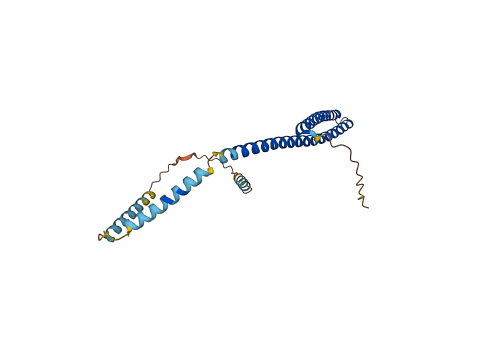| autophagosome maturation |
Removal of PI3P and Atg8/LC3 after the closure of the phagophore and before the fusion with the endosome/lysosome (e.g. mammals and insects) or vacuole (yeast), and that very likely destabilizes other Atg proteins and thus enables their efficient dissociation and recycling. |
| autophagy |
The cellular catabolic process in which cells digest parts of their own cytoplasm; allows for both recycling of macromolecular constituents under conditions of cellular stress and remodeling the intracellular structure for cell differentiation. |
| exit from mitosis |
The cell cycle transition where a cell leaves M phase and enters a new G1 phase. M phase is the part of the mitotic cell cycle during which mitosis and cytokinesis take place. |
| late endosome to lysosome transport |
The directed movement of substances from late endosome to lysosome. |
| late endosome to vacuole transport via multivesicular body sorting pathway |
The directed movement of substances from endosomes to vacuoles by a pathway in which molecules are sorted into multivesicular bodies, which then fuse with the vacuole. |
| maintenance of lens transparency |
A homeostatic process in which the lens is maintained in a highly refractive, transparent state to allow for optimal focusing of light on the retina. |
| membrane fission |
A process that is carried out at the cellular level which results in the separation of a single continuous membrane into two membranes. |
| midbody abscission |
The process by which the midbody, the cytoplasmic bridge that connects the two prospective daughter cells, is severed at the end of mitotic cytokinesis, resulting in two separate daughter cells. |
| mitotic cytokinesis |
A cell cycle process that results in the division of the cytoplasm of a cell after mitosis, resulting in the separation of the original cell into two daughter cells. |
| mitotic metaphase plate congression |
The cell cycle process in which chromosomes are aligned at the metaphase plate, a plane halfway between the poles of the mitotic spindle, during mitosis. |
| negative regulation of autophagosome assembly |
Any process that stops, prevents or reduces the frequency, rate or extent of autophagosome assembly. |
| negative regulation of cell death |
Any process that decreases the rate or frequency of cell death. Cell death is the specific activation or halting of processes within a cell so that its vital functions markedly cease, rather than simply deteriorating gradually over time, which culminates in cell death. |
| negative regulation of neuron death |
Any process that stops, prevents or reduces the frequency, rate or extent of neuron death. |
| nuclear membrane reassembly |
The reformation of the nuclear membranes following their breakdown in the context of a normal process. |
| nucleus organization |
A process that is carried out at the cellular level which results in the assembly, arrangement of constituent parts, or disassembly of the nucleus. |
| plasma membrane repair |
The resealing of a cell plasma membrane after cellular wounding due to, for instance, mechanical stress. |
| posttranslational protein targeting to endoplasmic reticulum membrane |
The targeting of proteins to a membrane that occurs after their translation. Some secretory proteins exhibit posttranslational transport into the endoplasmic reticulum (ER) lumen: they are synthesized in their entirety on free cytosolic ribosomes and then released into the cytosol, where they are bound by chaperones which keep them in an unfolded state, and subsequently are translocated across the ER membrane. |
| protein polymerization |
The process of creating protein polymers, compounds composed of a large number of component monomers; polymeric proteins may be made up of different or identical monomers. Polymerization occurs by the addition of extra monomers to an existing poly- or oligomeric protein. |
| regulation of autophagy |
Any process that modulates the frequency, rate or extent of autophagy. Autophagy is the process in which cells digest parts of their own cytoplasm. |
| regulation of centrosome duplication |
Any process that modulates the frequency, rate or extent of centrosome duplication. Centrosome duplication is the replication of a centrosome, a structure comprised of a pair of centrioles and peri-centriolar material from which a microtubule spindle apparatus is organized. |
| regulation of mitotic spindle assembly |
Any process that modulates the frequency, rate or extent of mitotic spindle assembly. |
| regulation of postsynapse organization |
Any process that modulates the physical form of a postsynapse. |
| ubiquitin-dependent protein catabolic process via the multivesicular body sorting pathway |
The chemical reactions and pathways resulting in the breakdown of a protein or peptide covalently tagged with ubiquitin, via the multivesicular body (MVB) sorting pathway; ubiquitin-tagged proteins are sorted into MVBs, and delivered to a lysosome/vacuole for degradation. |
| ubiquitin-independent protein catabolic process via the multivesicular body sorting pathway |
The chemical reactions and pathways resulting in the breakdown of a protein or peptide, via the multivesicular body (MVB) sorting pathway; proteins are sorted into MVBs, and delivered to a lysosome/vacuole for degradation. This process is independent of ubiquitination. |
| vesicle budding from membrane |
The evagination of a membrane, resulting in formation of a vesicle. |
| viral budding |
A viral process by which enveloped viruses acquire a host-derived membrane enriched in viral proteins to form their external envelope. The process starts when nucleocapsids, assembled or in the process of being built, induce formation of a membrane curvature in the host plasma or organelle membrane and wrap up in the forming bud. The process ends when the bud is eventually pinched off by membrane scission to release the enveloped particle into the lumenal or extracellular space. |
| viral budding from plasma membrane |
A viral budding that starts with formation of a membrane curvature in the host plasma membrane. |
| viral budding via host ESCRT complex |
Viral budding which uses a host ESCRT protein complex, or complexes, to mediate the budding process. |


